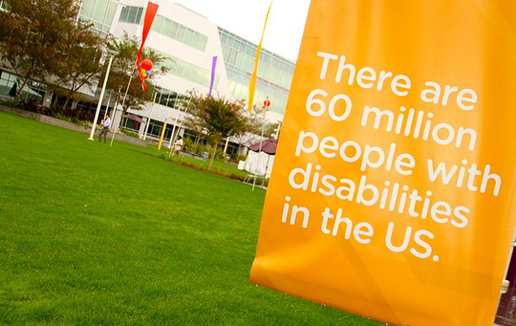 When you think of one of the over-60 million Americans who have a disability, what word comes to mind? Do you label that person with the description of the disability – a quadriplegic, an epileptic, and so on. If so, you are equating that person with the disability. The act of doing that is as stereotypical as racial profiling and is both insensitive and impolite. Access advocates know that sometimes the one wrong word can paint a thousand unsatisfactory stereotypes.
When you think of one of the over-60 million Americans who have a disability, what word comes to mind? Do you label that person with the description of the disability – a quadriplegic, an epileptic, and so on. If so, you are equating that person with the disability. The act of doing that is as stereotypical as racial profiling and is both insensitive and impolite. Access advocates know that sometimes the one wrong word can paint a thousand unsatisfactory stereotypes.
Use “People First Language”
Instead of labeling people with disabilities, try to be a disability advocate and use “People First Language.” It is not just political correctness; rather, using objective terms is best way of avoiding stereotypical assumptions about people with disabilities, who are, first and foremost, people.
Take this quiz!
Are you an access advocate? Take your own sensitivity inventory and try the following multiple-choice quiz: (The answer key is below, so no peeking!)
1. Which is the preferred descriptive term for disabled people?
a. the handicapped
b. the disabled
c. the challenged
d. people with disabilities
2. How should you refer to a person who has no disability?
a. a normal person.
b. a healthy person
c. a person without a disability
d. a typical person
3. A person born with a disability should be referred to as:
a. a person with a birth defect
b. a person who has a congenital disability
c. either a or b above
d. neither a nor b above
4. How does a disability advocate refer to someone unable to speak or hear?
a. a deaf mute
b. dumb
c. a person who is unable to speak, a person who uses a communication device.
d. a sign-language user
5. True or false: It is acceptable to refer to people who are blind or visually impaired as “the blind.”
6. Emphasizing abilities rather than limitations would include which of the following descriptions?
a. A man walks with crutches.
b. A woman is crippled.
c. Some people succeed despite their disability.
d. A person suffers from an unfortunate disability.
7. The term “handicap” should be used in the following sense:
a. To describe a person with a disability.
b. To refer to a barrier in the environment.
c. Never use the term. It is inappropriate.
d. Use it to describe the person as well as the environment.
8. When is it okay to refer to a person as “bound to” or “confined by” a wheelchair?
a. Never. Wheelchairs are actually liberating.
b. Never. Wheelchairs provide mobility.
c. Never. Wheelchairs break the confinement of a person who cannot walk.
d. All the above.
9. Euphemisms such as “physically challenged,” “inconvenienced” or “differently-abled” are:
a. condescending and are to be avoided.
b. cute enough to be used around children.
c. okay when used with good intentions.
d. to be used in place of terms like “retarded” or “crippled.”
10. Generally, using People First Language, what do you call people with disabilities?
a. the disabled
b. the handicapped community.
c. any other term you would use for a person (friend, neighbor, Uncle Bob, etc.)
d. All of the above.
Answer key:
1-d: The idea is to refer to what a person has, rather than what a person is.
2-c: This is the reverse application of the principle mentioned in question 1, above.
3-b: This one is far more objective and less stereotypical than “a person with a birth defect.”
4-c: If you got this one correct, you’re catching on! Describe the person by how the disability affects his or her abilities.
5-False. Shame on you if you missed this one! We refer to people with visual disabilities simply as “people who are blind” or “a person who is visually impaired.”
6-a: Notice the more positive connotation of what a person with a disability can do rather than what the limitations are?
7-b: Use the word in the sense that people with disabilities who use wheelchairs are handicapped by a lack of accommodations.
8-d: Okay. This was an easy one. Notice how the idea of the wheelchair can be of freedom and mobility?
9-a. Stay away from cute euphemisms. You’re dealing with people here.
10-c: People with disabilities are just people. Refer to them the same way you would to any other person.
If you did well on this quiz, it is because you figured out that to be an access advocate you first need truly regard a person with a handicap as a person. Looking for help in figuring out whether your local businesses and public facilities are removing barriers? Contact us. We advocate on behalf of people who want nothing more than to lead a productive life.
Image courtesy of Flickr, y.accesslab
